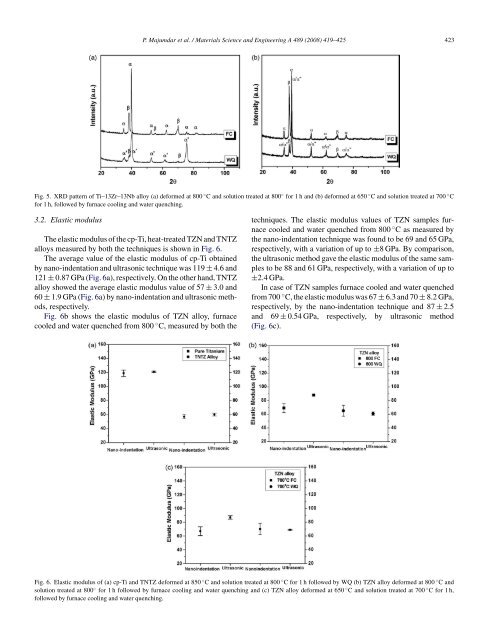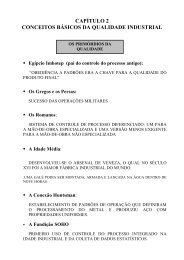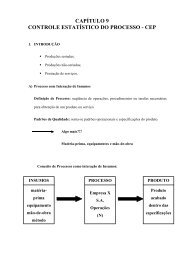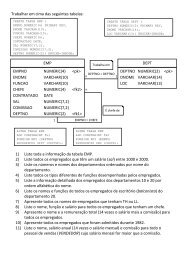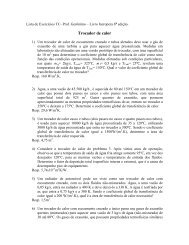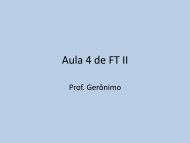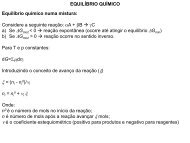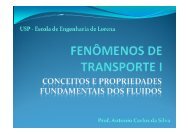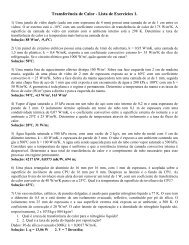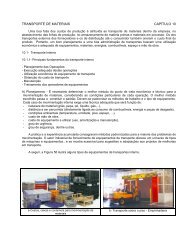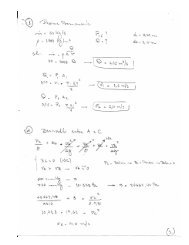Elastic modulus of biomedical titanium alloys by nano ... - Sistemas
Elastic modulus of biomedical titanium alloys by nano ... - Sistemas
Elastic modulus of biomedical titanium alloys by nano ... - Sistemas
You also want an ePaper? Increase the reach of your titles
YUMPU automatically turns print PDFs into web optimized ePapers that Google loves.
P. Majumdar et al. / Materials Science and Engineering A 489 (2008) 419–425 423Fig. 5. XRD pattern <strong>of</strong> Ti–13Zr–13Nb alloy (a) deformed at 800 ◦ C and solution treated at 800 ◦ for 1 h and (b) deformed at 650 ◦ C and solution treated at 700 ◦ Cfor 1 h, followed <strong>by</strong> furnace cooling and water quenching.3.2. <strong>Elastic</strong> <strong>modulus</strong>The elastic <strong>modulus</strong> <strong>of</strong> the cp-Ti, heat-treated TZN and TNTZ<strong>alloys</strong> measured <strong>by</strong> both the techniques is shown in Fig. 6.The average value <strong>of</strong> the elastic <strong>modulus</strong> <strong>of</strong> cp-Ti obtained<strong>by</strong> <strong>nano</strong>-indentation and ultrasonic technique was 119 ± 4.6 and121 ± 0.87 GPa (Fig. 6a), respectively. On the other hand, TNTZalloy showed the average elastic <strong>modulus</strong> value <strong>of</strong> 57 ± 3.0 and60 ± 1.9 GPa (Fig. 6a) <strong>by</strong> <strong>nano</strong>-indentation and ultrasonic methods,respectively.Fig. 6b shows the elastic <strong>modulus</strong> <strong>of</strong> TZN alloy, furnacecooled and water quenched from 800 ◦ C, measured <strong>by</strong> both thetechniques. The elastic <strong>modulus</strong> values <strong>of</strong> TZN samples furnacecooled and water quenched from 800 ◦ C as measured <strong>by</strong>the <strong>nano</strong>-indentation technique was found to be 69 and 65 GPa,respectively, with a variation <strong>of</strong> up to ±8 GPa. By comparison,the ultrasonic method gave the elastic <strong>modulus</strong> <strong>of</strong> the same samplesto be 88 and 61 GPa, respectively, with a variation <strong>of</strong> up to±2.4 GPa.In case <strong>of</strong> TZN samples furnace cooled and water quenchedfrom 700 ◦ C, the elastic <strong>modulus</strong> was 67 ± 6.3 and 70 ± 8.2 GPa,respectively, <strong>by</strong> the <strong>nano</strong>-indentation technique and 87 ± 2.5and 69 ± 0.54 GPa, respectively, <strong>by</strong> ultrasonic method(Fig. 6c).Fig. 6. <strong>Elastic</strong> <strong>modulus</strong> <strong>of</strong> (a) cp-Ti and TNTZ deformed at 850 ◦ C and solution treated at 800 ◦ C for 1 h followed <strong>by</strong> WQ (b) TZN alloy deformed at 800 ◦ C andsolution treated at 800 ◦ for 1 h followed <strong>by</strong> furnace cooling and water quenching and (c) TZN alloy deformed at 650 ◦ C and solution treated at 700 ◦ C for 1 h,followed <strong>by</strong> furnace cooling and water quenching.


